Family

 Eighteen years…not so many really, but in the life of a child, it’s…well, a lifetime…or at least a childhood. And then, that part of their life is over. They have graduated from high school, and begin their journey into the life of their choosing. That is a big step, and often one that their parents and grandparents aren’t really ready to have them take…but they are ready, and they will take that next step. I think that for this grandma, the hardest part of this particular now eighteen year old, is that my grandson, Caalab Royce has moved the furthest away, with no plans to move back here again. Usually when kids go away to college, they come home a lot during the year, but his parents moved to Washington and his school is there, so he won’t be coming here like his cousin, Chris Petersen does.
Eighteen years…not so many really, but in the life of a child, it’s…well, a lifetime…or at least a childhood. And then, that part of their life is over. They have graduated from high school, and begin their journey into the life of their choosing. That is a big step, and often one that their parents and grandparents aren’t really ready to have them take…but they are ready, and they will take that next step. I think that for this grandma, the hardest part of this particular now eighteen year old, is that my grandson, Caalab Royce has moved the furthest away, with no plans to move back here again. Usually when kids go away to college, they come home a lot during the year, but his parents moved to Washington and his school is there, so he won’t be coming here like his cousin, Chris Petersen does.
Thinking back on the years of Caalab’s life, my mind brings so many different moments to mind. Caalab was always my really huggy child, and anyone who knows him knows of his love of long hair. He couldn’t keep his fingers out of my long hair from the time he was just six months old. While I have had many children pull on or play with my hair, no other child was as gentle with it as Caalab was. Even at six months, he never pulled on it. If his play got to the point where it accidently pulled a little, I just told him to be gentle, and he was.
Caalab spent the night with us more than the other kids too. He just liked spending time with his Gma and Papa. Many kids grow out of that pretty early on, but he never did, and now that he lives so far away, those times that he spent the night become treasured memories for me. It didn’t matter what we did while he was there…even just watching television, because what mattered was that we got to spend together. He just liked being with us. Somehow, that never ceased to amaze me. It was a blessing beyond measure.
Caalab has changed in many ways over the years, and yet really, so very little. He is a loving, caring person with a tender heart. He hates to think that he might have hurt someone’s feelings, and will go out of his way to apologize or make amends if he thinks he might have hurt your feelings. It is a very endearing quality to have. It is also a quality that causes him to be one of the kindest people I have ever met. He is fun to be around, and 
 loves people. That makes him a very social person, who can be friends with anyone. Nevertheless, Caalab is a family sort of guy. He loves his parents and grandparents, and his sister, Shai considers him her best friend. And I can totally relate to that. He may be my grandson, but Caalab is my friend too, and since I am a family oriented person too, he is one of my very best friends. Today is Caalab’s 18th birthday, and the first one I really haven’t spent with him, and while that makes me sad, I hope this is the best birthday for him ever. Happy birthday Caalab!! Have an awesome day!! We love you!!
loves people. That makes him a very social person, who can be friends with anyone. Nevertheless, Caalab is a family sort of guy. He loves his parents and grandparents, and his sister, Shai considers him her best friend. And I can totally relate to that. He may be my grandson, but Caalab is my friend too, and since I am a family oriented person too, he is one of my very best friends. Today is Caalab’s 18th birthday, and the first one I really haven’t spent with him, and while that makes me sad, I hope this is the best birthday for him ever. Happy birthday Caalab!! Have an awesome day!! We love you!!
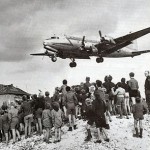 I think that every nation has opportunities to do what can be labeled as defining moments…situations when the nation dealt with an enemy or situation so well, that it can only be considered amazing. That was how the United States reacted to one of the most dramatic standoffs in the history of the Cold War. The Soviet Union decided to block off all road and rail traffic to and from West Berlin, Germany. The move was designed to basically starve the people into submission…or at least that was the plan. It was also a move that would be in defiance to all the other allies in Germany at the time. Unfortunately for the Soviet Union, the blockade turned out to be a horrible diplomatic move, but for the United States, it became a defining moment. The United States emerged from the confrontation with a renewed purpose and confidence, as well as a reputation for being a humanitarian nation.
I think that every nation has opportunities to do what can be labeled as defining moments…situations when the nation dealt with an enemy or situation so well, that it can only be considered amazing. That was how the United States reacted to one of the most dramatic standoffs in the history of the Cold War. The Soviet Union decided to block off all road and rail traffic to and from West Berlin, Germany. The move was designed to basically starve the people into submission…or at least that was the plan. It was also a move that would be in defiance to all the other allies in Germany at the time. Unfortunately for the Soviet Union, the blockade turned out to be a horrible diplomatic move, but for the United States, it became a defining moment. The United States emerged from the confrontation with a renewed purpose and confidence, as well as a reputation for being a humanitarian nation.
When World War II ended, Germany was divided into occupation zones. The United States, Great Britain, the Soviet Union, and eventually France were granted specific zones to occupy. Each nation was there to accept the surrender of Nazi forces and restore order. The Soviet Union occupied most of eastern Germany, and the other 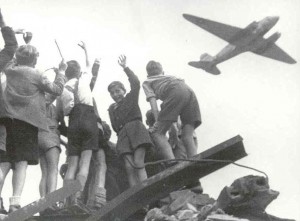 Allied nations occupied western Germany. The German capital of Berlin was divided into four sections as well. The differences between the United States and the Soviet Union were immediately evident. The Soviets were intent on thoroughly breaking the Germans…making them neutral and disarmed. Punishment was going to be at the top of the list. The United States saw things differently. They believed that the economic recovery of Western Europe depended of a strong, reunified Germany. The United States also felt that a rearmed Germany was going to be a stiff deterrent to further Soviet expansion into Western Europe. In May 1946, the Americans stopped reparations shipments from their zone to the Soviets. In December, the British and Americans combined their zones; the French joined some months later. The Soviets viewed these actions as a threat and issued more demands for more say in the economic future of Germany. On June 22, 1948, negotiations between the Soviets, Americans, and British broke down. On June 24, Soviet forces blocked the roads and railroad lines into West Berlin.
Allied nations occupied western Germany. The German capital of Berlin was divided into four sections as well. The differences between the United States and the Soviet Union were immediately evident. The Soviets were intent on thoroughly breaking the Germans…making them neutral and disarmed. Punishment was going to be at the top of the list. The United States saw things differently. They believed that the economic recovery of Western Europe depended of a strong, reunified Germany. The United States also felt that a rearmed Germany was going to be a stiff deterrent to further Soviet expansion into Western Europe. In May 1946, the Americans stopped reparations shipments from their zone to the Soviets. In December, the British and Americans combined their zones; the French joined some months later. The Soviets viewed these actions as a threat and issued more demands for more say in the economic future of Germany. On June 22, 1948, negotiations between the Soviets, Americans, and British broke down. On June 24, Soviet forces blocked the roads and railroad lines into West Berlin.
When the Soviets blocked the roads and railways, the Americans were furious. The question now became, what to do about it. Inside West Berlin there was panic. The people thought they were going to die. For a few tense 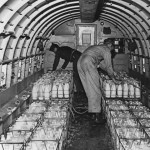 days, the world waited to see what the United States would do next. Then, just two days after the Soviets began the blockade, the United States reacted in a way that was so unexpected, and in the end, it would be a way that brought about that defining moment, and really set the stage for the humanitarian reputation the United States has today. A massive airlift of supplies was sent into West Berlin in what would become one of the greatest logistical efforts in history. For the Soviets, the escapade quickly became a diplomatic embarrassment. They looked like an international bully that was trying to starve men, women, and children into submission. The successful American airlift merely served to accentuate the technological superiority of the United States over the Soviet Union. On May 12, 1949, the Soviets officially ended the blockade.
days, the world waited to see what the United States would do next. Then, just two days after the Soviets began the blockade, the United States reacted in a way that was so unexpected, and in the end, it would be a way that brought about that defining moment, and really set the stage for the humanitarian reputation the United States has today. A massive airlift of supplies was sent into West Berlin in what would become one of the greatest logistical efforts in history. For the Soviets, the escapade quickly became a diplomatic embarrassment. They looked like an international bully that was trying to starve men, women, and children into submission. The successful American airlift merely served to accentuate the technological superiority of the United States over the Soviet Union. On May 12, 1949, the Soviets officially ended the blockade.
 While Bob and I were in San Francisco a number of years ago, we had the opportunity to ride the cable cars there. Cable cars, or trolley cars are pretty much a novelty in most places, but they used to be pretty commonplace. There are still many cities that operate a modern day version of the cable car, which is reality is more like a inter-city train than a cable car. But, the traditional cable car, street car, or trolley car were really very different from their modern day cousins, and the ride on the older version was really a lot of fun. Many cities had cable car systems that few people even remember. New York for example, has a huge subway system, but this came to be after the trolley system became problematic. Now, the old trolley system is just a faint memory, and in reality, one that is not very well known.
While Bob and I were in San Francisco a number of years ago, we had the opportunity to ride the cable cars there. Cable cars, or trolley cars are pretty much a novelty in most places, but they used to be pretty commonplace. There are still many cities that operate a modern day version of the cable car, which is reality is more like a inter-city train than a cable car. But, the traditional cable car, street car, or trolley car were really very different from their modern day cousins, and the ride on the older version was really a lot of fun. Many cities had cable car systems that few people even remember. New York for example, has a huge subway system, but this came to be after the trolley system became problematic. Now, the old trolley system is just a faint memory, and in reality, one that is not very well known.
In fact, problematic was maybe an understatement when it comes to reality concerning the cable car system. Once the automobile became a common item in the American household, there were a number of incidences involving the automobile and the trolley 
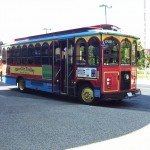 or cable car. I’m sure you can guess who won that battle. The trolley or cable car was bigger, and it was after all, limited as to where it could operate, while the automobile was free to go where it chose…pretty much anyway. Nevertheless, there were collisions between the two forms of transportation…as well as traffic jams at times. Eventually, with automobiles becoming so commonplace, the trolley or cable car began to go by the wayside…Finally ending up as the novelty it is today.
or cable car. I’m sure you can guess who won that battle. The trolley or cable car was bigger, and it was after all, limited as to where it could operate, while the automobile was free to go where it chose…pretty much anyway. Nevertheless, there were collisions between the two forms of transportation…as well as traffic jams at times. Eventually, with automobiles becoming so commonplace, the trolley or cable car began to go by the wayside…Finally ending up as the novelty it is today.
When my daughter, Corrie Petersen and I were in Minneapolis in August of 2005, we had the opportunity to take a city tour on an old trolley car. Of course this one was of the variety that had come out when the automobile came out. It needed no cable, but was rather a trolley car bus, I suppose. The seats and the windows were definitely authentic trolley car though. The tour was a lot of fun…probably mostly because it was a novelty trip. Bob and I had an additional opportunities in Alaska, on a tour of Anchorage. I really like the 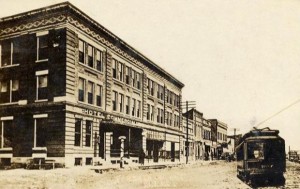 trolley car tours.
trolley car tours.
The other day I was looking at some old pictures of Montana history, and I came across something about Forsyth that I didn’t know about before. The little town of Forsyth, population about 1400 people in 1914, with one maim street is a place that you can easily walk across in just a few minutes. Nevertheless, the little town of Forsyth, Montana had a cable car in 1914, so people could ride the length of that main street…probably eight to twelve blocks. I was amazed to learn of that little tidbit of Forsyth history, which was the place where many of Bob’s family members lived, and where many still live today.
 Not every great grandmother is so blessed to have a really close relationship with their great grandchildren, and it is even more rare with the youngest of twenty great grandchildren, in which the oldest one is twenty four. My mother, Collene Spencer was a very blessed woman. Her relationship with her youngest great grandchild, Aleesia Spethman, who is my sister, Cheryl Masterson’s granddaughter, was one that was the rarest of the rare, and just as blessed for both of them. Aleesia has three older brothers, and at two years of age, taking her to all the activities the boys are into is difficult. That works our really well for my sister and it also worked quite well for our mom, because they got to see the baby often.
Not every great grandmother is so blessed to have a really close relationship with their great grandchildren, and it is even more rare with the youngest of twenty great grandchildren, in which the oldest one is twenty four. My mother, Collene Spencer was a very blessed woman. Her relationship with her youngest great grandchild, Aleesia Spethman, who is my sister, Cheryl Masterson’s granddaughter, was one that was the rarest of the rare, and just as blessed for both of them. Aleesia has three older brothers, and at two years of age, taking her to all the activities the boys are into is difficult. That works our really well for my sister and it also worked quite well for our mom, because they got to see the baby often.
For Aleesia, the two relationships were different, even though they lived in the same house, and spent the time together. She loved both her grandma and her great grandmother, but the relationships were very unique. Aleesia decided that Mom would be called GiGi. Aleesia is too young to know that our mom was her great grandmother. The name GiGi seemed very fitting to my sister, because Mom was, after all Aleesia’s great grandmother, or GG. Aleesia loved coming over to GiGi’s house. Every time she came over, she would run in calling for GiGi. Then she would run over to see her. Aleesia trusted GiGi implicitly. Every time she was there, she would pull Mom’s walker over to Mom’s chair and climb up on it. Then she would jump from it into Mom’s arms. It never occurred to Aleesia that Mom wouldn’t catch her…she knew her GiGi would always catch her. It was a relationship that was so sweet to watch.
When Mom went to Heaven, the family and especially Aleesia’s parents, Jenny and Steve Spethman, and my  sister, Cheryl, were worried about how Aleesia would deal with that, especially since Cheryl would continue to live in Mom’s house. She has done pretty well. She asked about Mom often at first, then she seemed to understand that GiGi wasn’t there, but even a two year old Aleesia is not immune to those ton of bricks moments. The other day, as Aleesia and my sister, her grandma, Cheryl were coming to the house to spend the evening at Mom’s house, Aleesia ran up to the door excitedly like she used to before, and knocking on it she said “We see GiGi?” Then she stopped and looked down, like she realized something. She turned and saw Mom’s car parked on the street, and with a really sad face, she said, “She’s not home.” Such a sad thing for a little two year old to have to try and understand, because her GiGi has always meant so much to her.
sister, Cheryl, were worried about how Aleesia would deal with that, especially since Cheryl would continue to live in Mom’s house. She has done pretty well. She asked about Mom often at first, then she seemed to understand that GiGi wasn’t there, but even a two year old Aleesia is not immune to those ton of bricks moments. The other day, as Aleesia and my sister, her grandma, Cheryl were coming to the house to spend the evening at Mom’s house, Aleesia ran up to the door excitedly like she used to before, and knocking on it she said “We see GiGi?” Then she stopped and looked down, like she realized something. She turned and saw Mom’s car parked on the street, and with a really sad face, she said, “She’s not home.” Such a sad thing for a little two year old to have to try and understand, because her GiGi has always meant so much to her.
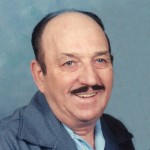
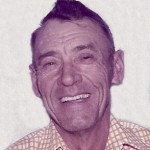 All dads are special in their own ways, whether they are dad to boys, girls, or a mix of both, once they become dads they truly become a totally different person. A man who has never been a dad, can love children or not, but when the children are his own, they are just different…special, and well…perfect. Their own children are always amazing, and its simply because their are their own. It doesn’t really matter if they wanted boys or girls, or some of each, because when that little one arrives, their Daddy’s Heart kicks into high gear and they find themselves thinking that there never was a greater kid than the one they were given. And each new child is viewed the same.
All dads are special in their own ways, whether they are dad to boys, girls, or a mix of both, once they become dads they truly become a totally different person. A man who has never been a dad, can love children or not, but when the children are his own, they are just different…special, and well…perfect. Their own children are always amazing, and its simply because their are their own. It doesn’t really matter if they wanted boys or girls, or some of each, because when that little one arrives, their Daddy’s Heart kicks into high gear and they find themselves thinking that there never was a greater kid than the one they were given. And each new child is viewed the same.
I’ve seen the Daddy’s Heart in so many people, beginning with my own dad, Allen Spencer, then with my  husband, Bob and his dad, Walt Schulenberg. Whatever their kids needed was priority. I don’t mean to say that we were all spoiled rotten, because we had rules and discipline, but when it came to making our lives wonderful, they were right there, making sure that we were so very blessed. It was not about lots of things, but rather the love they showed to us every day. Whenever things were wrong in our lives, there were our dads, with a hug and the words, “It will be alright.” And, of course, they were right. Everything was always alright, because our dads made sure of it, or maybe it was just their wisdom, in that they knew that the tragedies we faced today were most often not as bad as we thought they were, and tomorrow was another day…that would usually be much better, because things usually look very different the next day.
husband, Bob and his dad, Walt Schulenberg. Whatever their kids needed was priority. I don’t mean to say that we were all spoiled rotten, because we had rules and discipline, but when it came to making our lives wonderful, they were right there, making sure that we were so very blessed. It was not about lots of things, but rather the love they showed to us every day. Whenever things were wrong in our lives, there were our dads, with a hug and the words, “It will be alright.” And, of course, they were right. Everything was always alright, because our dads made sure of it, or maybe it was just their wisdom, in that they knew that the tragedies we faced today were most often not as bad as we thought they were, and tomorrow was another day…that would usually be much better, because things usually look very different the next day.
Then, I watched my sons-in-law, Kevin Petersen and Travis Royce step into that role with their children, I could see that another generation of children in my family were in the very best of hands. Their dads, just like my dad, my father-in-law, and my husband before them had the Daddy’s Heart. They would do their very best to 
 teach the kids the right way to go, and to fix the boo boos of life as they came along. Kevin and Travis are dads, and like all good dads, their kids are their top priority. And since their kids are pretty much grown now, I know that they will someday be the grandpas of their family. It is a place of honor and wisdom, and a place of being a little bit different kind of dad than they were before, but still a great blessing nevertheless. Happy Father’s Day to the dads in my life, and all dads everywhere. And a special Happy Father’s Day to my dad and my father-in-law in Heaven. We love and miss you very much, every day.
teach the kids the right way to go, and to fix the boo boos of life as they came along. Kevin and Travis are dads, and like all good dads, their kids are their top priority. And since their kids are pretty much grown now, I know that they will someday be the grandpas of their family. It is a place of honor and wisdom, and a place of being a little bit different kind of dad than they were before, but still a great blessing nevertheless. Happy Father’s Day to the dads in my life, and all dads everywhere. And a special Happy Father’s Day to my dad and my father-in-law in Heaven. We love and miss you very much, every day.
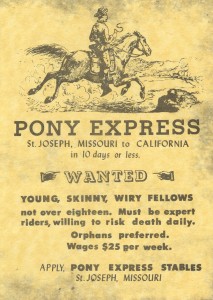 With this year marking the 155th anniversary of the Pony Express, there is much celebration in the arena of those who love to celebrate the history of the Pony Express. Every year the first couple of weeks in June find many riders marking the amazing accomplishments of the Pony Express by riding the route once again. The riders follow the original route from Saint Louis, Missouri to Sacramento, California. They travel on horseback, just as the original riders did, and they ride 24 hours a day, just as the riders before them. Today, June 20, 2015 puts them traveling through the state of Wyoming. They left Atlantic City, Wyoming June 20, 3:00am, Farson, Wyoming at 9:00am, Green River Crossing at 11:00am, Granger, Wyoming at 12:30pm, Uinta County Line at 1:00pm, Fort Bridger, Wyoming at 4:00pm, and cross the Wyoming/Utah state line at 9:00pm, arriving in This Is The Place Heritage Park in Utah in time to depart on Sunday, June 21, 3:30am, to continue on to their destination of Sacramento, California with a planned arrival at Old Sacramento, California on Thursday, June 25, 11:30am.
With this year marking the 155th anniversary of the Pony Express, there is much celebration in the arena of those who love to celebrate the history of the Pony Express. Every year the first couple of weeks in June find many riders marking the amazing accomplishments of the Pony Express by riding the route once again. The riders follow the original route from Saint Louis, Missouri to Sacramento, California. They travel on horseback, just as the original riders did, and they ride 24 hours a day, just as the riders before them. Today, June 20, 2015 puts them traveling through the state of Wyoming. They left Atlantic City, Wyoming June 20, 3:00am, Farson, Wyoming at 9:00am, Green River Crossing at 11:00am, Granger, Wyoming at 12:30pm, Uinta County Line at 1:00pm, Fort Bridger, Wyoming at 4:00pm, and cross the Wyoming/Utah state line at 9:00pm, arriving in This Is The Place Heritage Park in Utah in time to depart on Sunday, June 21, 3:30am, to continue on to their destination of Sacramento, California with a planned arrival at Old Sacramento, California on Thursday, June 25, 11:30am.
The Pony Express is one of the few services that achieved so much recognition in such a short history. The service opened officially on April 3, 1860, when riders left simultaneously from St. Joseph, Missouri, and Sacramento, California. The first westbound trip was made in 9 days and 23 hours and the eastbound journey in 11 days and 12 hours. The pony riders covered 250 miles in a 24-hour day. Eventually, it gre to more than 100 stations, 80 riders, and 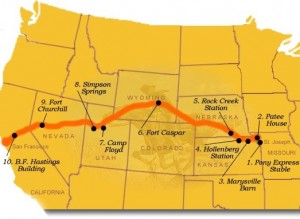 between 400 and 500 horses. Their delivery record was amazing in that during their run, only one mail delivery was lost. The service lasted only 19 months until October 24, 1861, when the completion of the Pacific Telegraph line ended the need for its existence.
between 400 and 500 horses. Their delivery record was amazing in that during their run, only one mail delivery was lost. The service lasted only 19 months until October 24, 1861, when the completion of the Pacific Telegraph line ended the need for its existence.
While it’s time was short, the Pony Exoress has become a beloved historic icon. In fact, in many ways, the service the Pony Express provided, makes our current mail service pale by comparison. I realize that there are many very good mail service workers, but there are also many who couldn’t care less about the mail they deliver, or the people sending or receiving it. They are, unfortunately, among the sorry generation of people who think a paycheck shouldn’t necessarily depend on the work performed, or not performed. That mentality was totally foreign to the Pony Express riders, who risked their very lives every day to make sure that communication in this great nation was possible. Happy 155th Anniversary to the Pony Express.
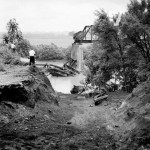 With all the rain we have been receiving, our area, along with many others have received multiple flash flood warnings, as well as flooding in many areas. When river water crosses a road, we are told not to drive through the flood, because it can take your car and cause your death. So many warnings are given to us in a flood situation. So much has been learned over the years about how to stay safe. So much has been learned about early warnings. So a lot of preparation is put in place, and yet, sometimes it’s just not enough. Such was the case on June 19, 1938.
With all the rain we have been receiving, our area, along with many others have received multiple flash flood warnings, as well as flooding in many areas. When river water crosses a road, we are told not to drive through the flood, because it can take your car and cause your death. So many warnings are given to us in a flood situation. So much has been learned over the years about how to stay safe. So much has been learned about early warnings. So a lot of preparation is put in place, and yet, sometimes it’s just not enough. Such was the case on June 19, 1938.
At that time, they didn’t have pickups that drove the rail system to check the tracks for problems. Instead a track walker was sent out to areas where there was a possible problem. Custer Creek is a small winding river that runs through 25 miles of the Great Plains on its way to the Yellowstone River. Minor streams like Custer Creek are prone to flash floods because their small capacity can quickly and easily be exceeded during heavy rains. A track walker was sent out to make sure everything was ok on the trestle at Custer Creek in Terry, Montana, and he reported that all was well there. Just a few hours later, a sudden downpour came through the area. The rising water in Custer Creek washed out the bridge and when the Olympian Special came through, it went crashing into the raging waters with no warning at all.
Two sleeper cars were immediately buried in the muddy waters, and the moonless night extremely hampered rescue efforts. In the end, 46 people lost their lives. The rear cars stayed above the water, but many passengers were seriously injured. To make matters worse, they could not be evacuated until the following morning. To hear of a train going into river in a flood is…at the very least, rare. I’ve heard of trains derailing…we all have, but this was different. On a moonless, pitch black night, my guess is that the engineer had no idea what 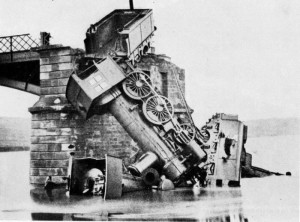 was about to happen. The shock must have been sickening to say the very least. Just knowing that people were going to die and there was nothing you could do about it, must have been the most horrible experience of an engineer’s life. Completely unimaginable.
was about to happen. The shock must have been sickening to say the very least. Just knowing that people were going to die and there was nothing you could do about it, must have been the most horrible experience of an engineer’s life. Completely unimaginable.
These days there are different safety measures in place, but that still doesn’t guarantee that such an event couldn’t happen again. I don’t know what the solution would be in these situations, but I’m sure that if there is one, technology will find a way to fix the problem. In those days, with the technology they had, they had done all they could, and yet, lives were still lost.
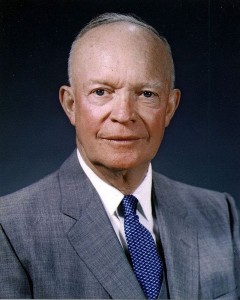 Not all of us can say that we knew a US President, before or during their presidency, but my uncle, Jim Wolfe could say that. Uncle Jim was in the army during World War II, and was on his way to England on a ship. Being the kind of guy who liked to see how things worked, Uncle Jim was laying on the back end of the ship watching the propeller go in and out of the water. Ike came up behind him and asked him if he was sick. Uncle Jim said, “No, I was just watching the prop.” Ike said, “Lord, man I would be so sick it would kill me and I’m on ships all the time.” He told Uncle Jim to come with him and they were going to go to Officers Mess and have coffee. Dad said “I can’t go there I will get in trouble.” Ike informed Uncle Jim that as long as he was with him, they wouldn’t say anything to him.
Not all of us can say that we knew a US President, before or during their presidency, but my uncle, Jim Wolfe could say that. Uncle Jim was in the army during World War II, and was on his way to England on a ship. Being the kind of guy who liked to see how things worked, Uncle Jim was laying on the back end of the ship watching the propeller go in and out of the water. Ike came up behind him and asked him if he was sick. Uncle Jim said, “No, I was just watching the prop.” Ike said, “Lord, man I would be so sick it would kill me and I’m on ships all the time.” He told Uncle Jim to come with him and they were going to go to Officers Mess and have coffee. Dad said “I can’t go there I will get in trouble.” Ike informed Uncle Jim that as long as he was with him, they wouldn’t say anything to him.
In the Officers Mess, Uncle Jim and Ike talked for a long time and then went their separate ways on the ship. When they got to England, Uncle Jim saw him a few times and then on D-Day, they found themselves on the same ship again. When they disembarked, they were under heavy fire, and my cousin Shirley Cameron tells me that Ike got a hold of her dad, my Uncle Jim and asked him how his shooting was. Uncle Jim said that it was good. Ike said, “See that guy in that tree way up there.” Uncle Jim said that he did, and Ike asked if he could hit him. Uncle Jim shot, hit, and killed the man. Ike said for Uncle Jim to stay with him. They were together for quite a while before they got separated. At that point, Uncle Jim was sent to another area.
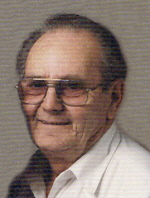
Uncle Jim ended up opening up some of the concentration camps. That was probably the worst part of his service. He said the men were like the walking dead. They were sick, weak, and skinny. All they could do was grab hold of him and thank him over and over for getting them out of that horrible place. Shirley tells me that he saw little wooden sheds that had bodies stacked from bottom to top, There were also pits that had bodies stacked in them ready for the heavy equipment to push the dirt over the top. She told me that experience gave him nightmares for years. He used to have pictures of all of that and the people that they helped out of the camps, but unfortunately they were lost in the fire that destroyed his home a number of years ago. After his time there, Uncle Jim was sent to France to help with the Liberation there. I’m sure he came home with many stories of the war, but as far as I know, that was the last time he ever saw the man who would later become our 34th US President, Dwight D Eisenhower…aka Ike.
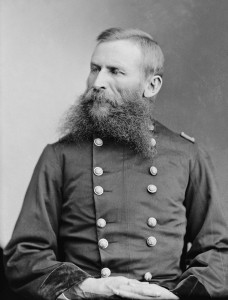 The states we now know as Montana and Wyoming, were originally supposed to belong to the Indians…a fact that many people don’t realize. Unfortunately, the White Man only stuck to a plan as long as the plan worked for the White Man. When gold was found in the Black Hills, there was no holding the White Man back. The plan was to try to buy the land from the Indians, but when that was not well received, they gave them an ultimatum…report to the reservations…or else. It was a matter of sell to us or we will take it…sound familar? The Indians simply did not take to the White Man’s plan very well. War broke out pretty quickly, and it was different than other wars, because the Indians did not play be the White Man’s rules of engagement. It was a very different type of war, and to win, the White Man would have to learn how to fight in a very different way. And it was a way they were not very good at.
The states we now know as Montana and Wyoming, were originally supposed to belong to the Indians…a fact that many people don’t realize. Unfortunately, the White Man only stuck to a plan as long as the plan worked for the White Man. When gold was found in the Black Hills, there was no holding the White Man back. The plan was to try to buy the land from the Indians, but when that was not well received, they gave them an ultimatum…report to the reservations…or else. It was a matter of sell to us or we will take it…sound familar? The Indians simply did not take to the White Man’s plan very well. War broke out pretty quickly, and it was different than other wars, because the Indians did not play be the White Man’s rules of engagement. It was a very different type of war, and to win, the White Man would have to learn how to fight in a very different way. And it was a way they were not very good at.
Most people remember the Battle of the Little Big Horn, in that so many men rode to their deaths. While Custer was in a place he shouldn’t have been, and a battle in which he was outnumbered, it is my opinion that he took a bad situation and did the best he could do with it. He went into battle knowing he would not survive it, and in that way it was brave. Even if the battle was not going to be won, it was brave. Still, that battle was not the only battle that showed bravery against daunting odds.
Just eight days earlier, Sioux and Cheyenne Indians won a major victory over General Crook’s forces at the Battle of the Rosebud. General Cook was in command of one of three columns of soldiers who were converging on the Big Horn Country of southern Montana that June. Sitting Bull, Crazy Horse, and several other chiefs had 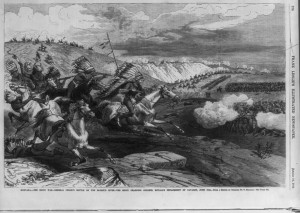 joined forces in the area. They were there in defiance on the US demands that the Indians confine themselves to the reservations. The army saw this protest as an opportunity to launch a massive three-proged attack, fully expecting to win a decisive vistory over the Indians.
joined forces in the area. They were there in defiance on the US demands that the Indians confine themselves to the reservations. The army saw this protest as an opportunity to launch a massive three-proged attack, fully expecting to win a decisive vistory over the Indians.
Crook and his men marched north from Fort Fetterman in Wyoming Terretory, intending to join the two others, the columns of General Gibbon and General Terry. General Terry’s force included the soon to be famous 7th Cavalry under the command of General George Custer. Given the distances between the troops and the lack of reliable communication, it was difficult to coordinate the three armys. Their plan was to converge on the valley of the Big Horn River and stage their assault. The biggest problem was that they had only a vague idea of how many men their enemy included, and they were way off.
Upon their arrival in the area, Crook’s scouts told him that there were signs of a major Sioux force in the area. Crook was convinced that the Sioux would run rather than fight, and he thought they were encamped near the Rosebud Creek. He wanted to attack before they had time to run. Unfortunately for him, they did not have the intel to know that they were severely outnumbered, not did he know that Crazy Horse was a brilliant war chief. The scouts tried to warn General Crook that Crazy Horse would never allow him to attack a stationary village, and he soon learned that they were right.
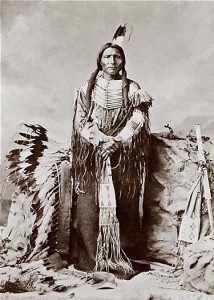 At around 8:00am on this day, June 17, 1876, Crook halted his force of 1,300 men in the bowl of a small valley along the Rosebud Creek to allow the rest of his men to catch up. The men unsaddled their horses, and within minutes a mass of Sioux Indians converged on them. They were hit by a force of 1,500 Sioux Indians and unbeknownst to Crook, Crazy Horse had an additional 2,500 warriors in reserve. Crazy Horse’s 4,000 warriors outnumbered Crook’s divided and unprepared army three to one. Had it not been for the wisdom and courage of Crook’s Indian allies, the battle would have ended just like the Battle of the Little Big Horn. There were numerous brave acts on both sides, including a Cheyenne girl who rescued her brother after his horse had been shot out from under him. In the end, 28 men were killed and 56 were seriously wounded. Crook withdrew his men. The warriors were emboldened and eight days later they joined up with their tribesmen in the Battle of the Little Big Horn, which of course, wiped out General George Custer and the 7th Cavalry.
At around 8:00am on this day, June 17, 1876, Crook halted his force of 1,300 men in the bowl of a small valley along the Rosebud Creek to allow the rest of his men to catch up. The men unsaddled their horses, and within minutes a mass of Sioux Indians converged on them. They were hit by a force of 1,500 Sioux Indians and unbeknownst to Crook, Crazy Horse had an additional 2,500 warriors in reserve. Crazy Horse’s 4,000 warriors outnumbered Crook’s divided and unprepared army three to one. Had it not been for the wisdom and courage of Crook’s Indian allies, the battle would have ended just like the Battle of the Little Big Horn. There were numerous brave acts on both sides, including a Cheyenne girl who rescued her brother after his horse had been shot out from under him. In the end, 28 men were killed and 56 were seriously wounded. Crook withdrew his men. The warriors were emboldened and eight days later they joined up with their tribesmen in the Battle of the Little Big Horn, which of course, wiped out General George Custer and the 7th Cavalry.
 On this day, June 16, 1961, the star of the Soviet Union’s Kirov Opera Ballet Company, Rudolf Nureyev defected while on a tour with the ballet company in France. He was 23 years old. It was a huge blow to the Soviet Union, both in the loss of Kirov Opera Ballet Company’s star, and that it severely damaged Soviet propaganda that touted the political and artistic freedom in Russia. But, Nureyev was not the first to defect, nor would he be the last. Communism had taken over Russia after the Russian Civil War, in which the Red Army successfully defended the Bolshevik government against various Russian and anti-Bolshevik armies. The Bolsheviks were Communist, and Russia would never be the same after their takeover.
On this day, June 16, 1961, the star of the Soviet Union’s Kirov Opera Ballet Company, Rudolf Nureyev defected while on a tour with the ballet company in France. He was 23 years old. It was a huge blow to the Soviet Union, both in the loss of Kirov Opera Ballet Company’s star, and that it severely damaged Soviet propaganda that touted the political and artistic freedom in Russia. But, Nureyev was not the first to defect, nor would he be the last. Communism had taken over Russia after the Russian Civil War, in which the Red Army successfully defended the Bolshevik government against various Russian and anti-Bolshevik armies. The Bolsheviks were Communist, and Russia would never be the same after their takeover.
My 4th great grandfather, Johann Georg Beyer was born in Germany in 1752, but the family immigrated to Russia in the mid 1700s, probably due to a poor economy in Gemany at the time. Later, when things heated up in Russia, the family decided to make the move to America. They worried about the impact Communism would have on their family, not to mention the fact that people were being pressed into service…even as young children. I believe that they got out pretty much in the nick of time to keep their family from being torn apart, however, one son was taken and to my knowledge, never heard from again.
There are many reasons why people would do everything they can to escape a Communist regime, and I’m sure that is also why Nureyev defected. I suppose that his life was different, since he had a talent that Russia wanted more than putting him in the army, but what if he could no longer dance? And what of his family should he have one? They might not be able to dance, and so might be forced to go into the army. And Russia has been saying that they had political and artistic freedom, but as we all know, that wasn’t true in reality. After defecting, Nureyev continued his career as a dancer. Over the next 30 years he danced with England’s Royal Ballet and the American Ballet Theatre. He was in great demand as both a dancer and choreographer, and even  made a few films, including an unsuccessful stint as the silent film star Rudolf Valentino. In 1983, he took over as ballet director of the Paris Opera. In 1989, he briefly returned to the Soviet Union to perform. He died in Paris in 1993.
made a few films, including an unsuccessful stint as the silent film star Rudolf Valentino. In 1983, he took over as ballet director of the Paris Opera. In 1989, he briefly returned to the Soviet Union to perform. He died in Paris in 1993.
While, Nureyev chose to return to Russia for a performance, possibly to show them that he was a free man, my grandfather’s family chose never to return to Russia, or to German as far as I know. It could have been that they distrusted the ability to get back out, but I think they just longed for a peaceful life, in a free nation, free from the tyranny of a corrupt government. That makes me wonder what they would think of things here in America now.

